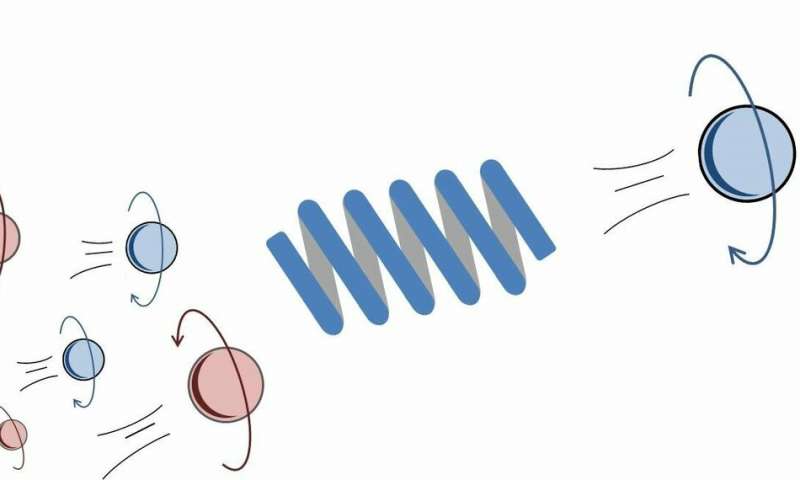Spintronics is promising for future low-power electronic devices. Spin is a quantum-mechanical property of electrons that can best be imagined as electrons spinning around their own axes, causing them to behave like small compass needles. A current of electron spins could be used in electronic devices. However, to generate a suitable spin current, you need a relatively large magnet. An alternative method that uses a special type of molecule has been proposed, but the big question is whether it works. University of Groningen Ph.D. student Xu Yang has constructed a theoretical model that describes how to test this new method.
Spin can have two directions, usually designated as “up” and “down.” In a normal electron current, there are equal quantities of both spin directions, but using spin to transfer information requires a surplus of one direction. This is usually done by injecting electrons into a spintronic device through a ferromagnet, which will favor the passage of one type of spin. “But ferromagnets are bulky compared to the other components,” says Yang.
DNA
That is why a 2011 breakthrough that was published in Science is attracting increased attention. This paper reported that passing a current through a monolayer of DNA double helices would favor one type of spin. The DNA molecules are chiral, which means they can exist in two forms which are mirror images, like a left and right hand. The phenomenon was dubbed “chiral induced spin selectivity” (CISS), and over the last few years, several experiments were published allegedly showing this CISS effect, even in electronic devices.
“But we were not so sure,” explains Yang. One type of experiment used a monolayer of DNA fragments, whereas another used an atomic force microscope to measure the current through single molecules. Different chiral helices were used in the experiments. “The models explaining why these molecules would favor one of the spins made lots of assumptions, for example, about the shape of the molecules and the path the electrons took.”
Find your dream job in the space industry. Check our Space Job Board »
Circuits
So Yang set out to create a generic model to describe how spins would pass through different circuits under a linear regime (i.e. the regime that electronic devices operate in). “These models were based on universal rules, independent of the type of molecule,” explains Yang. One such rule is charge conservation, which states that every electron that enters a circuit should eventually exit. A second rule is reciprocity, which states that if you swap the roles of the voltage and current contacts in a circuit, the signal should remain the same.
Next, Yang described how these rules would affect the transmission and reflection of spins in different components, for example, a chiral molecule and a ferromagnet between two contacts. The universal rules enabled him to calculate what happened to the spins in these components. He then used the components to model more complex circuits. This allowed him to calculate what to expect if the chiral molecules showed the CISS effect and what to expect if they did not.
Convincing
When he modeled the CISS experiments published so far, Yang found that some are, indeed, inconclusive. “These experiments aren’t convincing enough. They do not show a difference between molecules with and without CISS, at least not in the linear regime of electronic devices.” Furthermore, any device using just two contacts will fail to prove the existence of CISS. The good news is that Yang has designed circuits with four contacts that will allow scientists to detect the CISS effect in electronic devices. “I am currently also working on such a circuit, but as it is made up of molecular building blocks, this is quite a challenge.”
By publishing his model now, Yang hopes that more scientists will start building the circuits he has proposed, and will finally be able to prove the existence of CISS in electronic devices. “This would be a great contribution to society, as it may enable a whole new approach to the future of electronics.”
Provided by:
University of Groningen
More information:
Xu Yang et al. Spin-dependent electron transmission model for chiral molecules in mesoscopic devices. Physical Review B (2019). DOI: 10.1103/PhysRevB.99.024418
B. Gohler et al. Spin Selectivity in Electron Transmission Through Self-Assembled Monolayers of Double-Stranded DNA. Science (2011). DOI: 10.1126/science.1199339
Image:
Helical chiral molecules could select spins, thus creating a spin current. They are less bulky than the ferromagnets traditionally used to create spin currents.
Credit: Xu Yang, University of Groningen











